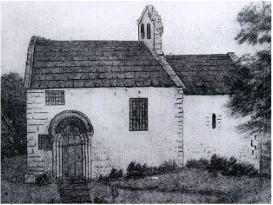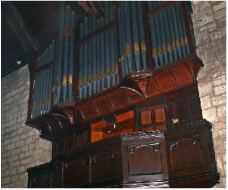History
A brief history of St Margaret's Church

The first place of worship in Swinton was a Norman chapel of ease to Wath church, built in about 1200 AD on the site of the present church hall. The small chapel was dedicated to St Mary Magdalene and was finally pulled down in 1815 before the construction of the new church. The two Norman arches were preserved and moved to the new churchyard when the Victorian church was consecrated in 1817. This church of St Margaret was destroyed by a fire in 1897, although the tower survived.
The body of the new church was built around the tower, using stone from local quarries at Mexborough, Darfield and Hooton Roberts. The church was consecrated by the Archbishop of York in October 1899.
More recently, an extensive refurbishment took place following a successful fund raising appeal under the ever enthusiastic leadership of our vicar, Fr Barley. Work on the church included re-ordering the chancel and Lady Chapel, repairs to the tower and refurbishment of the porch.
The body of the new church was built around the tower, using stone from local quarries at Mexborough, Darfield and Hooton Roberts. The church was consecrated by the Archbishop of York in October 1899.
More recently, an extensive refurbishment took place following a successful fund raising appeal under the ever enthusiastic leadership of our vicar, Fr Barley. Work on the church included re-ordering the chancel and Lady Chapel, repairs to the tower and refurbishment of the porch.
The church organ

Our organ was built in 1903 by Harrison and Harrison of Durham. The whole build was overseen by Mr Arthur Harrison and cost the sum of £637.00. It has been carefully protected over the last 100 years and remains in its original condition.
In the 1980s problems with the action were becoming apparent and many pipes were collapsing under their own weight. In 2006 a full rebuild took place, costing £96,000. The organ is entirely original and all of the pipe work remains, making this one of only two Harrison organs in original condition in South Yorkshire. It is a very fine instrument and a full programme of recitals is held each year. Please see our events page for more information.
The full specification of our Organ can be found HERE.
In the 1980s problems with the action were becoming apparent and many pipes were collapsing under their own weight. In 2006 a full rebuild took place, costing £96,000. The organ is entirely original and all of the pipe work remains, making this one of only two Harrison organs in original condition in South Yorkshire. It is a very fine instrument and a full programme of recitals is held each year. Please see our events page for more information.
The full specification of our Organ can be found HERE.
A brief history of Swinton Town
Swinton is a small town near Rotherham, South Yorkshire, with a population of approximately 15,000.
The earliest sign of a settlement at Swinton is a prehistoric man-made ridge which runs through Wath Wood. In 1853 a vase of 300 Roman coins was found near Rockingham Road, which indicates that there was a Roman settlement at some time.
In the Domesday book of 1086 the area is recorded as having “waste wood pasture”. Oak woodland is very suitable for rearing pigs and so it is likely that the name Swinton come from the old Anglo-Saxon for “Swine-Farm”.
For centuries the village was mainly rural, although in the 18th century two potteries were established. Rockingham Pottery became a world famous manufacturer of porcelain, and one of the original kilns, Waterloo Kiln, can still be seen is a small area of parkland. Other industries in the town included glass making and canal barge engineering, the latter of which is still active today. Swinton also grew as a result of the local coal mining industry, with large local pits at Manvers, Wath, Kilnhurst and Barnburgh.
In 1801 the population of the town was 653, and 200 years later it had risen to 12,217. Other local employment included an Iron Foundry, Iron and steel works, a tar distilling plant, a mineral water manufacturer and a GEC cooker assembly works.
A national school was opened in 1853 and a Board school in 1875. Electricity came with the tramway from Rotherham in 1907. Today, following the miners strike and the collapse of the mining industry, there is still some good industry in Swinton and, on the site of the old Manvers pit, call centres, factories and offices have been built which provide good employment for the area. Swinton is now largely residential, with 3 primary schools and one secondary comprehensive school. It is a pleasant place to live, near to the M1 and A1 motorways, and has excellent public transports connections by bus and train to Sheffield, Rotherham and Doncaster. There is a friendly community with St Margaret’s Church at the centre of the town, always seeking to proclaim the love of Jesus to all within our parish.
The earliest sign of a settlement at Swinton is a prehistoric man-made ridge which runs through Wath Wood. In 1853 a vase of 300 Roman coins was found near Rockingham Road, which indicates that there was a Roman settlement at some time.
In the Domesday book of 1086 the area is recorded as having “waste wood pasture”. Oak woodland is very suitable for rearing pigs and so it is likely that the name Swinton come from the old Anglo-Saxon for “Swine-Farm”.
For centuries the village was mainly rural, although in the 18th century two potteries were established. Rockingham Pottery became a world famous manufacturer of porcelain, and one of the original kilns, Waterloo Kiln, can still be seen is a small area of parkland. Other industries in the town included glass making and canal barge engineering, the latter of which is still active today. Swinton also grew as a result of the local coal mining industry, with large local pits at Manvers, Wath, Kilnhurst and Barnburgh.
In 1801 the population of the town was 653, and 200 years later it had risen to 12,217. Other local employment included an Iron Foundry, Iron and steel works, a tar distilling plant, a mineral water manufacturer and a GEC cooker assembly works.
A national school was opened in 1853 and a Board school in 1875. Electricity came with the tramway from Rotherham in 1907. Today, following the miners strike and the collapse of the mining industry, there is still some good industry in Swinton and, on the site of the old Manvers pit, call centres, factories and offices have been built which provide good employment for the area. Swinton is now largely residential, with 3 primary schools and one secondary comprehensive school. It is a pleasant place to live, near to the M1 and A1 motorways, and has excellent public transports connections by bus and train to Sheffield, Rotherham and Doncaster. There is a friendly community with St Margaret’s Church at the centre of the town, always seeking to proclaim the love of Jesus to all within our parish.